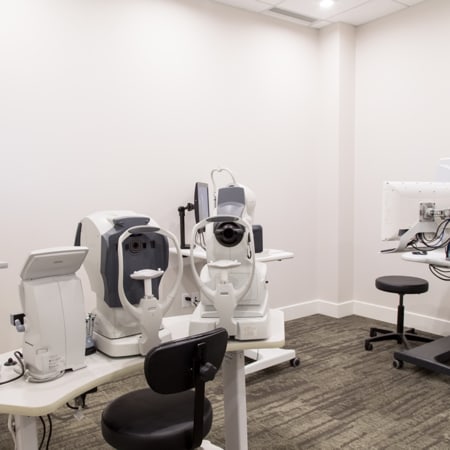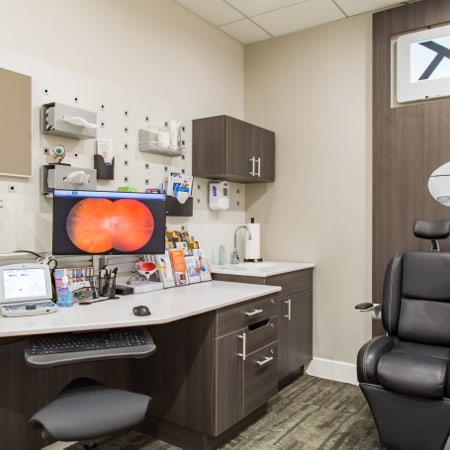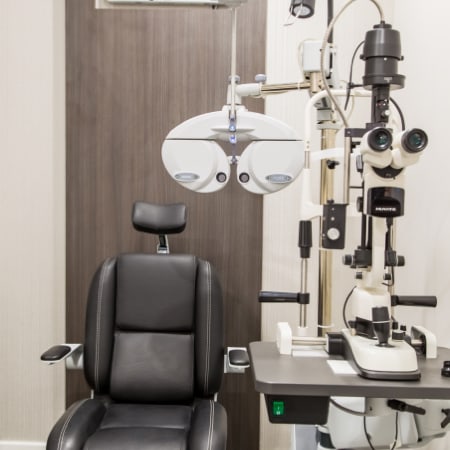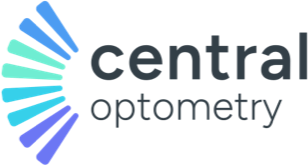Protecting Your Long-Term Vision
Eye disease can come in different forms, and your eye exam is about more than just updating your prescription—it also allows our team to check for early signs of eye disease.
The only way to detect many forms of eye disease is with a comprehensive eye exam. Early detection and treatment are critical and can slow or even help prevent vision loss. Regular eye exams allow us to detect and track subtle changes in your vision and eye health that may be indicators of eye diseases.
Your vision is precious, and we want to help preserve it—book your next appointment online today.

Early Detection & Treatment
The earlier we detect signs of eye disease, the sooner our team can begin preparing a personalized treatment plan to preserve your vision. OCTA retinal imaging allows us to pick up on abnormalities and signs of issues.
Regular eye exams are important and allow our team to detect possible issues early to get an early start on finding solutions.


Our Diagnostic Technology
To assist in the early detection of eye disease, we implement innovative diagnostic technology into our comprehensive eye exams.
Optical Coherence Tomography Angiography (OCT-A) is an imaging technique that allows for noninvasive visualization of blood vessels in the retina. With OCT-A, we can obtain detailed images of the retinal vasculature without the need for dye injection or invasive procedures. OCTA technology uses low-coherence interferometry to capture high-resolution, cross-sectional images.
OCT-A provides information for diagnosing and monitoring various eye conditions, including diabetic retinopathy, macular degeneration, and glaucoma.
Non-contact tonometry, often referred to as ‘air puff’ tonometry, employs a swift puff of air onto the eye’s surface. It is a noninvasive method that does not require any physical contact with the eye, making it a comfortable choice for many patients.
Goldmann applanation tonometry is widely regarded as the gold standard for intraocular pressure measurement. This technique involves applying a small, flat-tipped cone to the eye’s surface, following the application of numbing eye drops.
Corneal topography helps our team document the shape and curvature of your cornea. With corneal topography, we can accurately map the surface of your eye, helping to detect and monitor conditions such as astigmatism, keratoconus, and corneal irregularities.
Corneal topography is noninvasive and creates a detailed map of your cornea, allowing for a comprehensive assessment of your eye’s topography, aiding in the precise fitting of contact lenses and the evaluation of refractive surgery candidacy.
Whether you’re looking to diagnose age-related macular degeneration (AMD) or monitor its progression, AdaptDx Pro is a simple and fully automated dark adaptometer that can make a significant impact on patient care.
AdaptDx Pro is a diagnostic tool that measures the speed of dark adaptation in your eyes. With advanced eye tracking technology, it provides accurate measurements of your dark adaptation function. The AdaptDx Pro test determines the number of minutes it takes for your vision to adjust to darkness, giving valuable insights into your overall eye health.
Macular pigment density testing is a diagnostic method for assessing the health of your eyes. With this technology, we can now actively monitor and protect the vital macular pigment in your eyes. By measuring the density of this pigment, our team can accurately assess your risk for vision loss and develop personalized treatment plans.
Ultra-widefield imaging helps us capture a comprehensive view of your eye in a single image. With ultra-widefield imaging, your eye care professional can detect and diagnose a range of eye conditions with greater precision and efficiency.
By using a specialized camera, this advanced technique provides a wider field of view, allowing for the early detection and treatment of eye diseases.
Neurolens is designed to alleviate painful symptoms experienced by 80% of patients with eye misalignment. These innovative glasses feature contoured prism lenses, providing effective treatment for headaches, neck/shoulder pain, and eyestrain.
Neurolens can offer relief from digital eye strain symptoms and improve visual clarity.
Axial length measurements can help our team accurately measure the length of your and your child’s eye, providing information about conditions such as myopia (nearsightedness) and glaucoma.
By actively assessing the axial length, your doctor can tailor personalized treatment plans for your specific needs.
The Different Forms of Eye Disease
Eye disease can come in different forms, and we want to help our patients understand them. Exploring different forms of eye disease can help our patients recognize some of the early signs and schedule an eye exam for a detailed checkup and diagnosis.
Our eye disease evaluations and exams are all about the details and getting a complete picture when it comes to your eye health.
Age-related macular degeneration (AMD) is a progressive disease that affects your central vision by damaging the macula. This damage can make activities like reading and driving more difficult. AMD is a leading cause of vision loss among older adults, and there are different types.
- Subclinical AMD is a subtle yet progressive process that results in night vision difficulty, impaired dark adaptation, and impairment at this level takes place at least 3 years before drusen are visible.
- Dry AMD is the more common form of the disease and occurs in early, intermediate, and late stages. This form of AMD occurs when the macula thins with age.
- Wet AMD is the less common form of the disease that causes faster and more severe vision loss. Wet AMD occurs when abnormal blood vessels grow in the back of the eye and damage the macula.
Cataracts develop when the normally clear lens in your eye becomes clouded. The cloudy nature of cataracts can vary from small areas to larger areas that cause a noticeable loss of vision.
Symptoms of cataracts can include:
- Blurry vision
- Decreased night vision
- Muted colours
If cataracts progress to an advanced stage and prevent you from going about your daily activities, such as reading or driving, cataract surgery can be an effective way to remove them and restore your vision.
Glaucoma is a group of eye conditions that cause damage to the optic nerve, which is responsible for sending visual information to your brain. Damage to the optic nerve can lead to vision loss and blindness if not detected and treated early.
Damage from glaucoma can be caused by high pressure in the eye, known as intraocular pressure. Risk factors for glaucoma can include:
- Age
- Family history
- Previous eye injuries
Maintaining a regular eye exam schedule is key to monitoring changes in your vision due to glaucoma. We test for glaucoma using non-contact tonometry and Goldmann applanation tonometry.
As you age, the occasional flashes and floaters may be more common—however, a sudden appearance is your clue to reach out to your eye doctor.
Flashes can happen in one or both of your eyes and come in different shapes. The frequency can vary and can signal an eye emergency.
Floaters appear as small lines or cobwebs in your field of vision. While appearing to be in your central vision, floaters are composed of tiny clumps of gel or cells. If you experience sudden flashes of light accompanied by a shower of floaters, you may be experiencing a retinal tear or retinal detachment.
A retinal detachment is a serious condition that can cause permanent vision loss if not treated quickly. Seek immediate medical assistance if you think you may be experiencing retinal detachment.
Diabetes can increase the risk of developing eye diseases such as cataracts and diabetic retinopathy, which is the primary vision loss concern for patients with diabetes. As many as 1 million Canadians are living with undiagnosed diabetes.
Diabetic retinopathy is a condition that causes damage to the blood vessels of the retina. This damage is caused by a buildup of excess sugar in your blood and can lead to a number of health issues.
Conjunctivitis is characterized by an inflammation of the conjunctiva, the transparent tissue covering the inner eyelids and whites of your eyes. This inflammation causes the blood vessels in the conjunctiva to become more visible, leading to eye redness.
There are 3 types of conjunctivitis:
- Viral conjunctivitis
- Bacterial conjunctivitis
- Allergic conjunctivitis
Uveitis is an eye disease characterized by inflammation of the uvea, the middle layer of the eye. This condition can cause discomfort, blurred vision, redness, and light sensitivity.
It can stem from various factors, such as infections, autoimmune disorders, or even unknown origins. Regardless of its source, uveitis demands attention and prompt treatment.
Early detection is crucial for managing uveitis and preventing potential complications. Regular eye exams and prompt medical attention are essential for preserving your ocular health.
Dry eye is an inflammatory condition that occurs when your tears aren’t adequately providing lubrication to your eyes. This occurs because your eyes are not producing enough tears and/or because the tears produced are of poor quality.
There are many different symptoms of dry eye. Some common symptoms can include:
- Excessive tearing
- Scratchiness and/or a burning sensation
- A feeling of something foreign in the eye
- Difficulty wearing contact lenses
Learn more about our dry eye treatment options by visiting our Dry Eye Therapy Page.
Epiretinal membrane is a prevalent eye condition that affects the retina, the light-sensitive tissue at the back of your eye. This condition occurs when a thin layer of scar tissue forms on the surface of the retina, leading to various vision problems.
It typically develops due to age-related changes in the vitreous, the gel-like substance that fills the center of the eye. As the vitreous shrinks and pulls away from the retina, it can leave behind remnants that form the membrane.
If the symptoms are mild we may just observe, however, if vision is severely affected, surgical procedures like vitrectomy or membrane peeling may be recommended to improve visual clarity.
Keratoconus is a progressive eye disease that affects the shape of your cornea, the clear front surface of your eye. This condition weakens the cornea, causing it to thin and bulge into a cone-like shape, leading to distorted vision.
While the exact cause is still unknown, it is believed to be influenced by genetic factors and environmental triggers. Early detection and intervention are key to managing this condition effectively.
Specialized contact lenses can help improve vision and allow you to live with keratoconus.
Address Eye Disease Today
Our team is dedicated, experienced, and equipped to help you manage different forms of eye disease. Book your appointment online today and get a head start on managing the early signs of eye disease.














